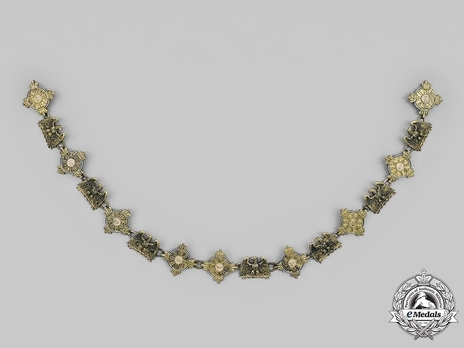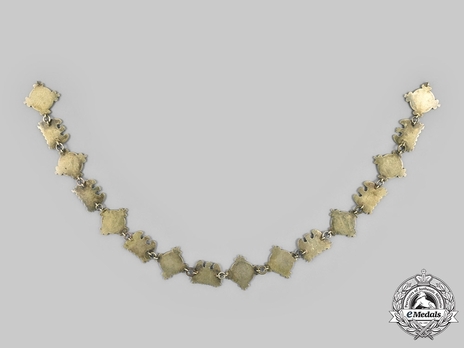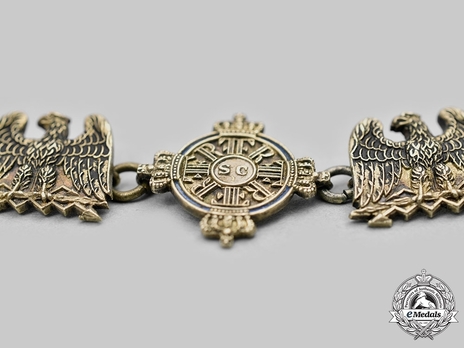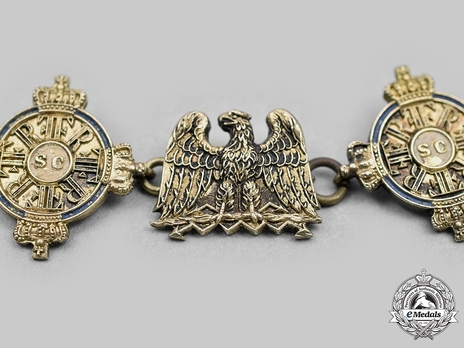High Order of the Black Eagle, Collar Miniature
CATEGORY: Miniature
SKU: 01.PRU.0101.101.01.M.000
Estimated market value:




Estimated market value:
In silver gilt, a miniature collar comprising 16 total links, with 9 links featuring a circular decoration with a dark blue enamelled ring with crowns at 12, 3, 6 and 9 o’clock, the interior presents a ring of letters FR and reversed F and the central medallion presenting the letters SC (representing SUUM CUIQUE), cypher links measure 15.16mm (w) x 14.90mm (h) with 7 links portraying large black eagles on thunderbolts, each eagle link measures 12.65mm (w) x 9.63mm (h), entire length measures 241mm, reverse of each link is plain with two integral rings at 3 and 9 o’clock, numerous connecting rings on reverse have been replaced, collar has been cleaned showing light abrasion marks on reverse, very poor enamelling throughout, two cypher links have been reconnected upside down, integral suspension ring of end link broken off, possibly missing an eagle link, fine condition.
The High Order of the Black Eagle was founded by Elector Friedrich III of Brandenburg on the day before his coronation to become King Friedrich I of Prussia. Elector Friedrich III instituted the Order to demonstrate the importance and dignity of Prussia within the European hierarchy.
The order was primarily conferred upon foreign and domestic princes, heads of state, and dignitaries in recognition of extraordinary civil and military merit and achievements. It was also awarded to members of the Prussian military.
The black eagle was chosen to symbolize justice, and to represent the coat of arms of the state. The eagle clutches a laurel wreath in one claw, as the reward of justice, and a lightning bolt, the punishment of justice, in the other claw.
The statutes for the order were largely based on the Danish Order of the Elephant, British Order of the Garter, and Spanish Order of the Golden Fleece. In line with these other European orders, the number of Knights was set at 30, not including the royal princes who were awarded the order at the time of their birth. For non-royal Knights, the minimum age was set at 30. However, the membership limit was not observed between 1713 to 1847, when the 30 member limit only applied to residents.
From 1703 to 1847, the order was only awarded to members of nobility who could trace their lineage through multiple generations.
The order featured only one grade, which included a Collar, Cross, and an associated Breast Star. The reigning king could award the order with or without the collar. The order members had to wear their decorations at all times or risk fines for violating the order’s rules. Knights of foreign states were allowed to wear the cross on a neck ribbon or a ribbon bow on the chest.
The first 19 awards of the order took place on January 17, 1701. The recipients swore by the statutes and received the decoration on the shoulder ribbon at the appointment, and at the investiture would receive the chain from the king. In May 1742, Marie August, widowed Duchess of Württemberg, was the first woman to be awarded the order.
In 1809, King Friedrich Wilhelm III considered expanding the order into four classes, with a decoration with a wreath for sub-officials, etc. However, this plan was transferred to the Red Eagle Order in January 1810.
On February 20, 1847, King Friedrich Wilhelm IV amended the order to include individuals who were not of noble lineage. These recipients, in turn, would receive hereditary nobility.
The order decorations could be conferred with diamonds to members of royal families and other high-ranking recipients for exceptional merit. In 1743, Elisabeth Petronova, Empress of Russia was awarded the order with diamonds, with a value of 40,000 thalers. In 1762, Catherine II, Empress of Russia received the order with pearls, with a value of 30,000 thalers.
The order's motto was "Suum Cuique", which translates to “To each according to their merits”.
The order was discontinued in 1918.
The Collar consisted of a chain of gold with 24 large links, with alternating crowned monogram links and black eagle links. The middle link is always a monogram link, and the cross hangs from eight small links and two elongated rings.
Exact records were not kept prior to 1810, and therefore exact numbers are not known. In total, approximately 339 Collars were awarded. In 1853, it was decided that to keep the memory of past recipients alive, the name of the recipients, the date of their investiture, and the date of their death (as of 1859) was recorded on the reverse of an eagle link. When all the eagle links were full, as Collars were returned after death and re-awarded, that Collar would no longer be awarded.
In 1786, King Friedrich Wilhelm III ordered a chain made for Frederick the Great by jeweller Louis Baudesson. This was the first collar made after 1713.
King Friedrich Wilhelm IV reintroduced collars in 1848, however they were usually often conferred upon granting capitular honours, and to crowned heads and princes.

Comments
Sign in to comment and reply.


Scroll Top